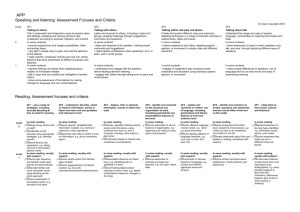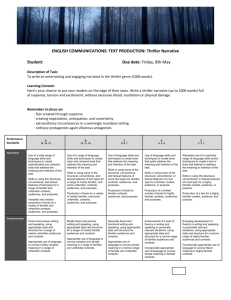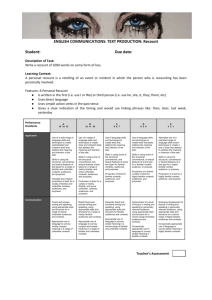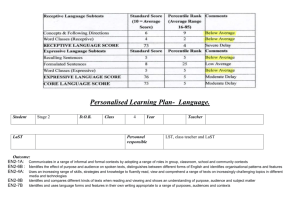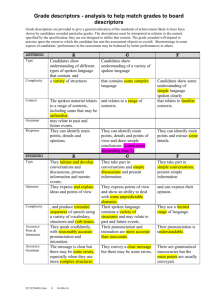Student 2 response (C grade)
advertisement
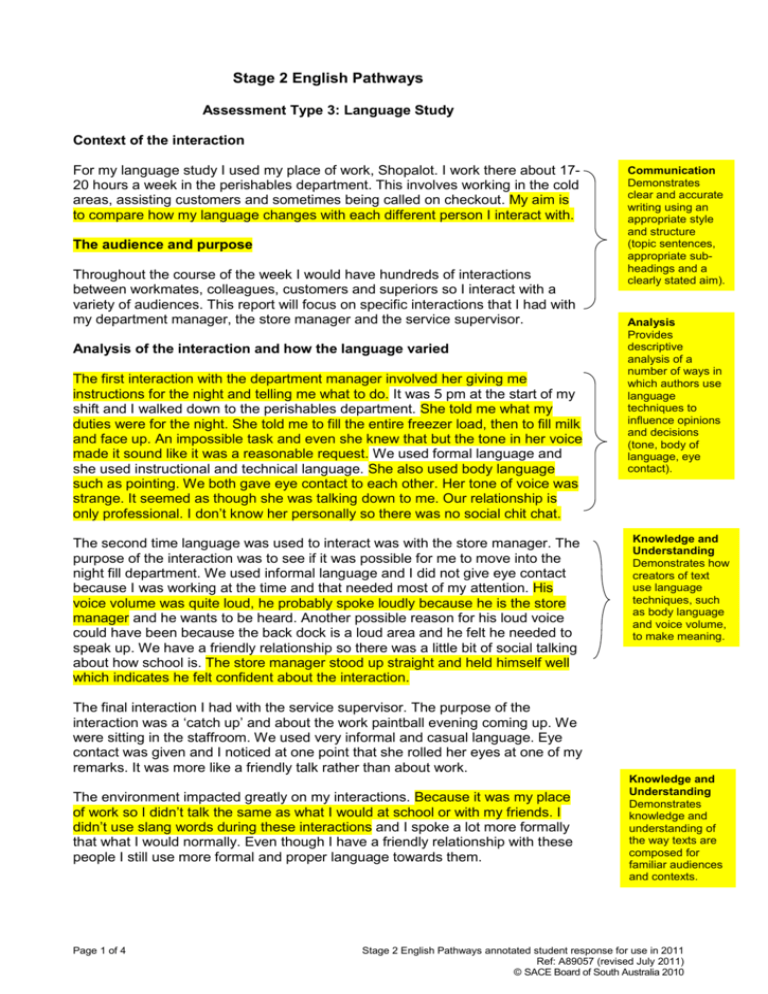
Stage 2 English Pathways Assessment Type 3: Language Study Context of the interaction For my language study I used my place of work, Shopalot. I work there about 1720 hours a week in the perishables department. This involves working in the cold areas, assisting customers and sometimes being called on checkout. My aim is to compare how my language changes with each different person I interact with. The audience and purpose Throughout the course of the week I would have hundreds of interactions between workmates, colleagues, customers and superiors so I interact with a variety of audiences. This report will focus on specific interactions that I had with my department manager, the store manager and the service supervisor. Analysis of the interaction and how the language varied The first interaction with the department manager involved her giving me instructions for the night and telling me what to do. It was 5 pm at the start of my shift and I walked down to the perishables department. She told me what my duties were for the night. She told me to fill the entire freezer load, then to fill milk and face up. An impossible task and even she knew that but the tone in her voice made it sound like it was a reasonable request. We used formal language and she used instructional and technical language. She also used body language such as pointing. We both gave eye contact to each other. Her tone of voice was strange. It seemed as though she was talking down to me. Our relationship is only professional. I don’t know her personally so there was no social chit chat. The second time language was used to interact was with the store manager. The purpose of the interaction was to see if it was possible for me to move into the night fill department. We used informal language and I did not give eye contact because I was working at the time and that needed most of my attention. His voice volume was quite loud, he probably spoke loudly because he is the store manager and he wants to be heard. Another possible reason for his loud voice could have been because the back dock is a loud area and he felt he needed to speak up. We have a friendly relationship so there was a little bit of social talking about how school is. The store manager stood up straight and held himself well which indicates he felt confident about the interaction. Communication Demonstrates clear and accurate writing using an appropriate style and structure (topic sentences, appropriate subheadings and a clearly stated aim). Analysis Provides descriptive analysis of a number of ways in which authors use language techniques to influence opinions and decisions (tone, body of language, eye contact). Knowledge and Understanding Demonstrates how creators of text use language techniques, such as body language and voice volume, to make meaning. The final interaction I had with the service supervisor. The purpose of the interaction was a ‘catch up’ and about the work paintball evening coming up. We were sitting in the staffroom. We used very informal and casual language. Eye contact was given and I noticed at one point that she rolled her eyes at one of my remarks. It was more like a friendly talk rather than about work. The environment impacted greatly on my interactions. Because it was my place of work so I didn’t talk the same as what I would at school or with my friends. I didn’t use slang words during these interactions and I spoke a lot more formally that what I would normally. Even though I have a friendly relationship with these people I still use more formal and proper language towards them. Page 1 of 4 Knowledge and Understanding Demonstrates knowledge and understanding of the way texts are composed for familiar audiences and contexts. Stage 2 English Pathways annotated student response for use in 2011 Ref: A89057 (revised July 2011) © SACE Board of South Australia 2010 Person Purpose Store manager Friendly chat. About moving into night fill and how work was going. Perishables manager To see what work I had to do for the shift Casual talk about the paint ball day Service supervisor Type of interaction Face to face Language used Semi formal. Personal Body Language Hand gestures Surroundings Other Back dock Store room Face to face Formal Instructional Technical Procedural Hand gestures Pointing Perishables cool room and freezer No eye contact Back dock is a loud area – impacted on interaction Confident posture by store manager Eye contact Interruptionsphone call Face to face Casual Informal Personal Hand gestures Staffroom Locker rooms Eye contact, rolling of the eyes, extraneous noise Timing of the conversation was rushed. I had two specific examples of effective communication. The first effective interaction was with the department manager. I listened to the information given and I asked appropriate questions that related to what she said. This helped me achieve the tasks I was given. If I didn’t ask the appropriate questions I could’ve performed my duties poorly. The second effective communication I had was with the service supervisor. We spoke about the paintball event and she told me the dates and what things to bring. It was an effective interaction because if I didn’t listen intently I wouldn’t have known to bring old clothes. The most challenging aspect of my communication was speaking to the service supervisor. I had to listen very closely to avoid making a mistake with my work and it was difficult to take in the appropriate information. The most successful aspect of my communication was speaking with the store manager. I put reasons across as to why I wanted to move departments and I used appropriate language which helped me get what I wanted. The most surprising aspect of my communication was also talking to the store manager. It was surprising when he actually agreed with what I was saying. I used the right language to persuade him in to letting me move departments and it surprised me when he agreed. Communication Uses appropriate language to convey the simple meaning that effective communication involves listening. Analysis Demonstrates competent analysis of some aspects of the technical roles of language that support effective interactions in different contexts including the work place. I think my interactions were successful and I achieved what I wanted in each interaction. I used appropriate language for each different person. I used formal language when it was needed and I gave appropriate eye contact when that was needed. Page 2 of 4 Stage 2 English Pathways annotated student response for use in 2011 Ref: A89057 (revised July 2011) © SACE Board of South Australia 2010 Conclusion I learnt that I talk very differently around different people. It was interesting to see how each interaction compared to one another. I purposely chose three different people to interact with. I spoke to each person according to what relationship I have with that particular person and I think I applied that well. My tone and body language also changes dramatically. Communication changes massively in our everyday life without us even knowing it. Some of the time we do this self consciously. We change our type of language, tone, volume, body language and eye contact depending on who we are interacting with and this happens with everyone everyday. Some improvements that can be made to insure I have successful interactions are to further improve the way I use different language around different people. Word count 1075 Additional Comments This is a “C” grade example. A review of the study provides evidence of demonstrated skills in reproducing some of the structural, conventional and textual features of a report (e.g. appropriate paragraphing, use of sub headings, clear and concise language) (Application) Note: For the Language study, the student’s choice of topic influences which specific features are a focus, although all assessment design criteria are to be addressed. Page 3 of 4 Stage 2 English Pathways annotated student response for use in 2011 Ref: A89057 (revised July 2011) © SACE Board of South Australia 2010 Performance Standards for Stage 2 English Pathways A Knowledge and Understanding Analysis Application Communication Detailed knowledge and understanding of the ideas, values, and beliefs in familiar and unfamiliar texts. Detailed analysis of complex connections between personal experiences, ideas, values, and beliefs, and those explored in familiar and unfamiliar texts. Use of a comprehensive range of language skills to interact effectively in different contexts, and to analyse and solve simple and complex problems. Perceptive analysis of a range of ways in which authors use language techniques to influence opinions and decisions in familiar and unfamiliar texts. Location, recording, analysis, and synthesis of knowledge relevant to familiar and unfamiliar contexts. Fluent and precise writing and speaking, using an appropriate style and structure for a range of mainly unfamiliar audiences and contexts. Knowledge and understanding of the ways in which the creators and readers of familiar and unfamiliar texts use a range of language techniques to make meaning. B C Comprehensive knowledge and understanding of the ways in which familiar and unfamiliar texts are composed for a range of purposes and audiences. Perceptive analysis of aspects of familiar and unfamiliar cultural, social, and technical roles of language that support effective interactions in different contexts. Sound knowledge and understanding of some ideas, values, and beliefs in familiar, and some unfamiliar, texts. Analysis of some complex connections between personal experiences, ideas, values, and beliefs, and those explored in familiar, and some unfamiliar, texts. Use of a sound range of language skills to interact effectively in different contexts, and to solve simple and complex problems. Knowledge and understanding of the ways in which the creators and readers of mainly familiar texts use some language techniques to make meaning. Well-considered analysis of a range of ways in which authors use language techniques to influence opinions and decisions in familiar, and some unfamiliar, texts. Location, recording, analysis, and occasional synthesis of knowledge relevant to mostly familiar contexts. Sound knowledge and understanding of the ways in which mainly familiar texts are composed for some purposes and audiences. Well-considered analysis of aspects of mainly familiar, and some unfamiliar, cultural, social, or technical roles of language that support effective interactions in different contexts. Knowledge and understanding of some ideas, values, or beliefs in familiar texts. Competent analysis of simple connections between personal experiences, ideas, values, or beliefs, and those explored in familiar texts. Use of competent language skills to interact effectively in different contexts, and to solve routine problems in familiar contexts. Descriptive analysis of a number of ways in which authors use language techniques to influence opinions and decisions in familiar texts. Location, recording, and occasional analysis of knowledge relevant to a familiar context. Knowledge and understanding of the ways in which the creators and readers of a narrow range of familiar texts use some language techniques to make meaning. D Knowledge and understanding of the ways in which familiar texts are composed for familiar purposes and audiences. Competent analysis of some aspects of mainly familiar cultural, social, or technical roles of language that support effective interactions in different contexts. Identification of some simple ideas, values, or beliefs in some familiar texts. Reference to simple connections between uncomplicated personal experiences, ideas, values, or beliefs, and those explored in familiar texts. Knowledge and understanding of the ways in which the creators and readers of a narrow range of familiar texts use a restricted range of language techniques to make simple or factual meaning. Knowledge of the ways in which familiar texts are composed for personally relevant purposes and familiar audiences. E Sophisticated skills in reproducing the structural, conventional, and textual features of text types for a range of familiar and unfamiliar contexts, audiences, and purposes. Identification of a simple idea, value, or belief in a familiar text. Some knowledge and emerging understanding of the way in which a creator or reader of a highly familiar text uses a language technique to make factual meaning. Some knowledge of the ways in which highly familiar texts are composed for personally relevant purposes and highly familiar audiences. Page 4 of 4 Reference to some ways in which authors use language techniques to influence opinions and decisions in familiar texts. Reference to some simple aspects of familiar cultural, social, or technical roles of language that support effective interactions in one or more contexts. Sound skills in reproducing some of the structural, conventional, and textual features of text types for a range of mainly familiar, and some unfamiliar, contexts, audiences, and purposes. Skills in reproducing some of the structural, conventional, and textual features of some text types for familiar contexts, audiences, and purposes. Use of a restricted range of language skills to interact in familiar contexts, and to solve simple problems. Location and recording of factual knowledge relevant to a familiar context. Limited skills in reproducing some of the structural, conventional, or textual features of a text type for a familiar context, audience, or purpose. Recognition of a simple connection between a straightforward personal experience, idea, value, or belief, and that explored in a highly familiar text. Use of a restricted range of language skills to interact in highly familiar contexts, and to solve simple problems. Reference to the way in which an author uses language techniques to influence opinions and decisions in a highly familiar text. Location or recording of factual knowledge relevant to a highly familiar context. Recognition of some simple aspects of highly familiar cultural, social, or technical roles of language that support effective interactions in one or more contexts. Restricted skills in reproducing a limited number of structural, conventional, or textual features of a text type for a highly familiar context, audience, or purpose. Appropriate use of language to convey mostly complex meaning in a range of familiar and unfamiliar contexts. Mostly fluent and precise writing and speaking, using an appropriate style and structure for a range of mostly familiar audiences and contexts. Appropriate use of language to convey complex and simple meaning in a range of familiar, and some unfamiliar, contexts. Generally clear and accurate writing and speaking, using an appropriate style and structure for familiar audiences and contexts. Appropriate use of language to convey simple meaning in a narrow range of familiar and unfamiliar contexts. A level of fluency in writing and speaking in personally relevant situations, using an appropriate style and structure for a narrow range of familiar audiences and contexts. Occasionally appropriate use of language to convey simple meaning in familiar contexts. Emerging development of fluency in writing and speaking in personally relevant situations, using an appropriate style and structure for a narrow range of highly familiar audiences and contexts. Occasionally appropriate use of language to convey literal meaning in highly familiar contexts. Stage 2 English Pathways annotated student response for use in 2011 Ref: A89057 (revised July 2011) © SACE Board of South Australia 2010

